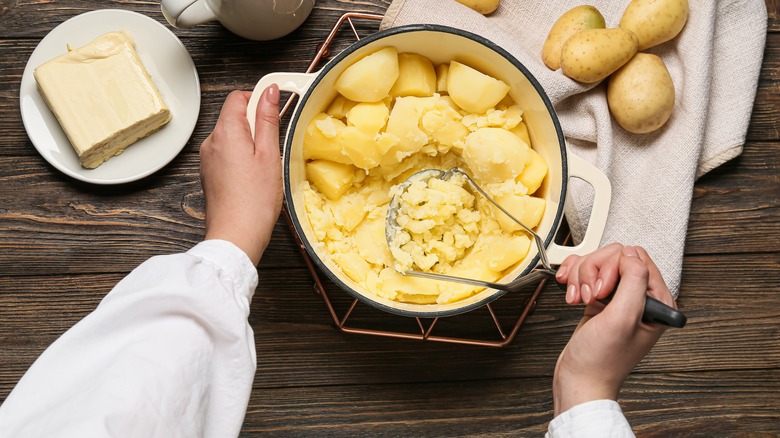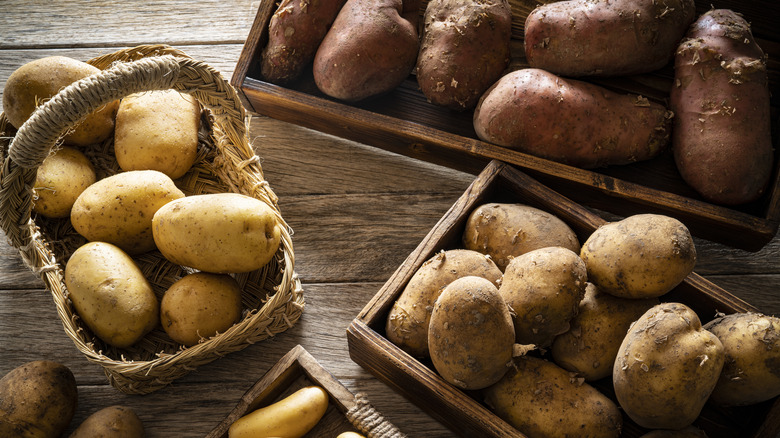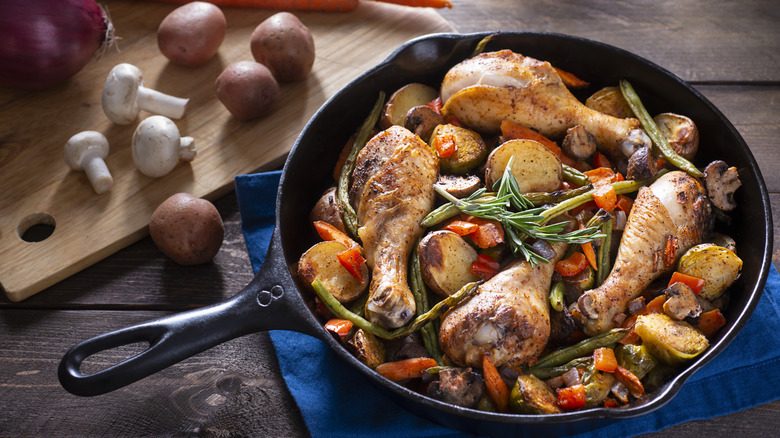The Absolute Worst Potato Variety For Mashing
Whether it's hand-punched french fries or latkes with sour cream, potatoes make for some of the finest finger foods and side dishes in the game. However, no potato dish is quite as comforting as a heaping pot of mashed spuds. Creamy, fluffy, satiating, and versatile to boot, mashed potatoes might just be the perfect food. However, as simple as they are to make, you shouldn't use just any old potato, and if there's one potato cultivar you should always avoid, it's red potatoes.
Beyond color and shape, potatoes can be characterized by two defining features — their moisture and starch content. Red potatoes are waxy, which means they are high moisture, low starch tubers. Instead of softening up, red potatoes hold their shape well when boiled, which makes them difficult to mash. Even when you finally do mash them, they're not adept at absorbing butter and milk, which can lead to a less cohesive and gummy texture.
Best potatoes for mashing
If red potatoes are not ideal for mashing, then which potatoes are better? Next time you're planning on making a pot of whipped or mashed potatoes, opt for cultivars with opposing characteristics to red ones. In this case, you'll want to use potatoes with low moisture and high starch content. Low-moisture, high-starch potatoes are easier to mash and more efficient at absorbing milk and butter for a lush and creamy consistency.
Yukon gold potatoes are a quintessential option for mashed spuds. Not only do they have the ideal moisture and starch content, but they also have a naturally buttery and downhome flavor for lip-smacking good mashed potatoes. Can't find Yukons? Although they're more neutral in taste, Russet potatoes also have the necessary qualities for a great mash and can take on the flavors of your favorite fixings whether it be bacon grease country gravy or aromatic herbs.
Sweet potatoes, although they have a slightly higher moisture and starch content than the aforementioned spuds, are still an excellent option for mashing when you want something on the candied side. As long as you have one of these starchy cultivars, and avoid the common mistakes foodies make when mashing potatoes, you're in for a treat.
Alternative uses for red potatoes
Just because they aren't suitable for mashing, doesn't mean red potatoes can't have a place in your rotation of meals. They're ideal for a wide range of potato-based dishes where the spuds need to hold their shape and structure. Red nugget potatoes are perfect for crispy smashed potatoes, for example.
Another tasty way to put red potatoes to use is by roasting them. When cut into bite-sized pieces and roasted with herbs and spices, red potatoes transform into a flavorful side dish with a crunchy exterior and soft, tender interior. Because they won't get mushy and soft when cooked, red potatoes are also great options for crafting a potato salad, ensuring that each bite offers a substantial and well-structured mouthful. Similarly, because they won't fall apart when simmered, red potatoes work great in soups and stews.
In reality, all potatoes are great potatoes, but some varieties are better suited for specific dishes than others. Whether you're using them as a base for a slow-braised meat dish or enjoying them straight out of the pot, mashed potatoes are best made without red spuds.


